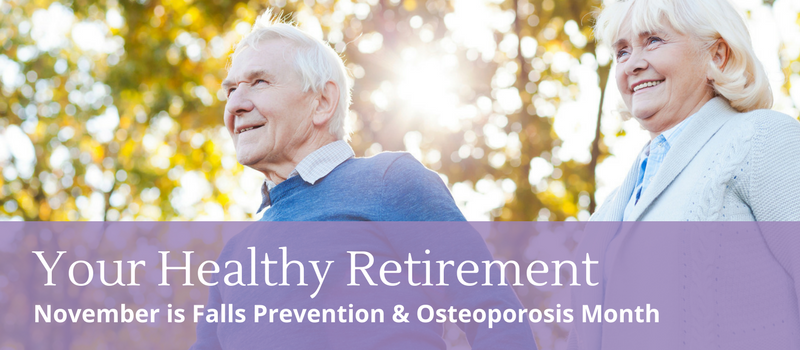 Retirement represents a new beginning full of possibilities, adventures and most importantly, fun! Chances are your retirement is the result of goal-setting and hard work, and you have a vision for your future. A vision of a future that includes physical strength, mobility, and independence is achievable with a plan, and the good news is it is never too late to make changes necessary to realize it.
Retirement represents a new beginning full of possibilities, adventures and most importantly, fun! Chances are your retirement is the result of goal-setting and hard work, and you have a vision for your future. A vision of a future that includes physical strength, mobility, and independence is achievable with a plan, and the good news is it is never too late to make changes necessary to realize it.
Falls Prevention
Preventing falls and related injuries is as important as financial planning for a healthy retirement, and begins with appreciating your individual risk factors. Our ability to maintain and regain balance is our best defence against falling, so anything that may interfere with balance like chronic disease, illness, vision impairment, or muscle weakness, warrants careful consideration. Medications prescribed to manage chronic disease, pain, and illness may also contribute to falls risk if dizziness or drowsiness, or changes in blood pressure are possible side effects. Speaking with your health professional about how your health affects your risk of falls is a great place to start, but there are also non-medical measures you can take to prevent falls.
We can modify risk factors that are related to lifestyle, like footwear to help prevent trips and slips; diet to ensure we have good nutrition to ward off illness and promote health; and avoiding unnecessary risk. What you may not know is that your secret weapon for preventing falls may be just a call or visit away because life satisfaction and participation in social activities have been shown to have “protective” effects that reduce falls that result in hip fracture. If there weren’t already enough good reasons to pick up the phone, join in activities, and have fun, you have one more!
“We can modify risk factors that are related to lifestyle, like footwear to help prevent trips and slips; diet to ensure we have good nutrition.”
Preventing falls is particularly important for people with a condition that causes deterioration of bone tissue, known as osteoporosis. Osteoporosis is tricky because there are no symptoms, but the disease results in weakened bones that render them more prone to fracture with hips, spine, wrist and shoulders being most vulnerable. Often times the disease isn’t diagnosed until a fracture occurs, usually at an advanced stage. Are you at risk?
Osteoporosis
Women are more at risk of developing osteoporosis, and Osteoporosis Canada estimates that 1 in 3 women will have a fracture related to osteoporosis in their lifetime. Osteoporosis is most common over the age of 50 in Canada, and those with previous fractures who are lean are at even greater risk. Men are also at risk of developing osteoporosis; with 25% of all hip fractures resulting from osteoporosis occurring in men, though with more devastating consequences however. Gender isn’t the only consideration.
Medical conditions like diabetes, liver disease, kidney disease, and lung diseases may increase risk of developing osteoporosis, so managing chronic conditions is important for bone health too. Smoking and alcohol consumption are also linked to an increased risk of osteoporosis, so taking steps to reduce these may improve your ability to maintain healthy bones and decrease your risk for fractures.
“Women are more at risk of developing osteoporosis, and Osteoporosis Canada estimates that 1 in 3 women over the age of 50 are affected.”
Osteoporosis can be prevented, and in some circumstances, the effects of the disease can be reversed. Timing is important, however, with treatment being more effective earlier in the disease process. While medications for improving bone health and density for people with osteoporosis are available, there are diet and lifestyle changes we can make now to reduce our risk of developing the disease. Nutrition is important in bone health, and supplementation with calcium and vitamin D are often recommended, though consultation with your physician, pharmacist, or Nurse Practitioner is important to avoid any potential interactions with medications you may be already taking. Also, speak with your health professional before starting new physical activity, as exercise is also recommended to promote healthy bones.
Reducing risk for osteoporosis and falls requires planning and possibly a few changes, but these are well worth the benefits you may reap, including improved quality of life and sustained independence. Who knows, you may also make a few new friends and spread falls prevention benefits with others just by gathering with friends, both old and new, and having fun.
How a Sifton Retirement lifestyle can help
At Sifton Retirement Living, our residents enjoy opportunities to participate in a variety of activities and social events, delicious and nutritious meals prepared by exceptional chefs, exercise and falls-prevention classes, as well as individual attention from our Wellness staff. Visiting pharmacists consult with residents receiving medication administration support regarding their medications, and our Wellness Managers work with residents to assess fall risk and work with collaboratively to develop a plan to help prevent falls. We are committed to supporting your vision of a mobile and independent you!
With November being falls prevention and osteoporosis month, there is no time like today to work on your healthy retirement plan! Speak with our on-site wellness team to discuss our Falls Prevention classes and other healthy activities to support your wellness goals!